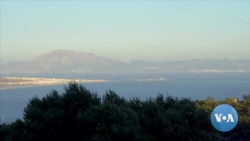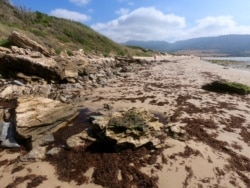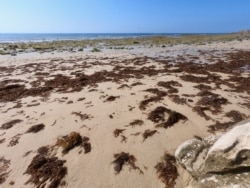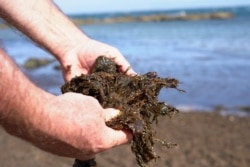As tourists finally return to Spain's beaches this summer, they may be facing an unpleasant surprise: patches of thick brown algae that have washed up on the golden sands of its most popular resorts.
Metric tons of Rugulopteryx okamurae — an alga believed to come from Asia in the ballast tanks of cargo ships — lie on the beaches of resorts in southern Spain in an invasion which threatens the already struggling tourism industry, upsets marine biodiversity and has left local fishermen with near-empty nets.
Elsewhere in the Mediterranean, the same brown sludge has appeared on the other side of the Straights of Gibraltar on the coast of northern Morocco.
With the same texture as seaweed, it can cause mild irritation to the skin if touched during swimming, and the plant's rotting remains are an eyesore for tourists.
Below the waves, this new arrival to this part of the Mediterranean stops local algae from developing and drives away fish and mollusks that cannot feed on this inedible plant.
Environmental nightmare
“It is aggressively taking over the entire sea floor of the Straits of Gibraltar because the algae take up 50% of the space between ten and 20 meters below the surface,” said Francisco Ruíz Giraldez, the mayor of Tarifa, a popular holiday destination for kite surfers, in an interview with VOA.
“It is an environmental nightmare because it invades the habitat of local vegetation and kills it off. It causes a problem for the fishermen because it gets caught up in their nets and they cannot catch anything.”
Ruíz Giraldez, who is also a biologist, added: “This is a big problem for tourism as metric tons of dead algae leave a nasty brown stain on the beach and does not look good and it begins to smell bad.”
The speed at which the algae reproduce means it is a race against time to rid Spain's beaches of this unsightly stain.
“It’s like Groundhog Day. You take the [algae] away one day and the next day it’s back again,” said Ruíz Giraldez.
Last year officials cleared 5,000 metric tons of the algae from the beaches of Tarifa alone.
Along the coast in Estepona, another popular tourist resort, authorities had to get rid of 3,383 metric tons of the plant, while in Marbella some 1,500 metric tons of the algae was cleaned up.
Scientists said this type of algae naturally exists in the Pacific Ocean but it has been transported in the ballast tanks of cargo vessels that travelled through the Mediterranean.
Scientists have said similar algae invasions in Mexico and China were on a greater scale but did not spread as fast as in one in the Mediterranean. On the eastern side of the sea, a similar infestation is also occurring off Turkey’s shores.
At the other end of the Mediterranean, the sargassum, or brown algae known as sea snot, is a type of fast-spreading microorganism that threatens Turkey’s shorelines and the ecosystem of both the Mediterranean and the Aegean seas, warned Professor Barbaros Çetin, a biologist who worked for the Turkish environment ministry, told the Daily Sabah newspaper.
Researchers in Spain are voicing similar concerns.
José Carlos García Gomez, a professor of marine biology at the University of Seville, told VOA the rugulopterix okamurae algae is native to the warm waters near China, Korea, the Philippines, and Japan. He said it is believed to have arrived in Spain on board ships that sail through the Strait of Gibraltar.
"What is happening in Spain and in the seas off Turkey involves different types of algae, but it is the same process. These are what is called wild invasive algae which take over the local ecosystem and cause serious environmental damage," Antonio Vegara, a teacher of business culture at the Further Education Section in Tarifa and a member of Citizens Against Invasive Algae, told VOA.
“The problem is that it grows at such a fast rate that it displaces other local species of algae and dominates the sea,” said Vegara, a conservationist who has studied the algae.
“We have asked the regional and national government for help to try to get rid of it but there is a saying in Spain ‘we will come back tomorrow’ or 'we will carry out a study',” he said, indicating help is slow in coming.
Andalusia’s regional government has pledged $1.78 million in compensation for fishermen.
Vegara hopes to turn this natural pest to a positive use, by developing a way to make creams for cosmetic use from the rotting plant but they are not on the market yet.
Economic toll
For local fishermen, the invasive plant is a threat to their livelihoods.
“There are no other algae near the coast so there is nothing for the fish to live on. And it also clogs up their nets. This means that the fishermen are catching less,” Juanjo Quintero, a diver who also works as a fisherman, told VOA.
Fishing fleets in southern Spain have strict limits on the red tuna that they can catch, and the fish do not feed on the algae.
José Carlos García Gomez led a study on algae published in April in the magazine Frontiers in ecology and evolution.
“This alga is eliminating rivals. The other plants and fish or animals which live between ten and 20 meters below the sea have been forced out because they cannot live off this as it is made of a material which is not edible to many species in the Mediterranean, so it takes over,” professor García Gomez told VOA.
“I have never seen algae reproduce so fast anywhere in the world. Normally these macro-algae can be contained because the environment adapts to them, but I have not seen any evidence of this yet,” he said.









